Salon Pricing Guide for 2024
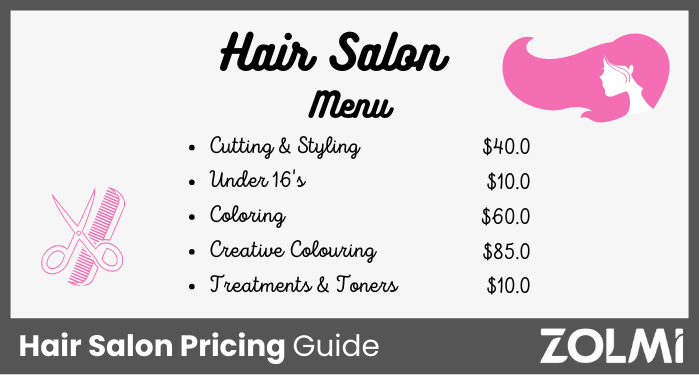

Making decisions about your salon pricing strategy is one of the most important things you will do when you start your salon business. It’s also something that you should stay on top of and adjust as needed, even for the most successful salons.
While coming up with a price list for your hair salon services might seem a bit intimidating at first, don’t worry. There are many things that you can do as a hair salon owner to make this easier.
In order to set the right salon prices, you’ll need to understand how they’re calculated. It’s also helpful to get an idea of your competitor’s pricing strategies as well as the general demographic of your hair salon clientele.
All of this together will help you to see the “big picture” and come up with a plan for how to price your hair services.
In this article, we’ll go over some effective pricing strategies as well as what to think about when setting profitable salon prices. We’ll also take a look at some of the tools and tips available to help you come up with the best salon pricing formula for your business.
When you’re deciding how to set salon prices, there are a few key factors that you should consider. A salon’s location and target market, for example, will help you determine both which salon services to offer clients as well as what you will want to charge your customers for each service.
Other things that could impact your hair salon price list are whether a product or service is in high demand, what your competition is doing, and the overall value of each item that you’re offering. Let’s go over all of these in a bit more detail:
It can be tempting to discount your prices to get those all-important first bookings, but remember that you still need to pay the bills. At the end of the day, you can’t charge less than you’re spending, if you want your hair salon to make money.
As a salon owner, you’ll need to know your Break Even Point or BEP for each item on your menu. Figure out how much each service is costing you in terms of supplies, staff and time spent, and make sure your prices at least cover these things. After this, anything you make will be your profits.
Look closely at your business’s location. This can tell you a lot about your clients and how to approach your pricing process. If you’re setting up shop in a high-end or busy area, chances are you can charge a bit more.
Of course, this also depends on how many competitors you have nearby and what they’re charging. Before you decide on your price list, it’s important to do some research and check each one’s website.
Your hair salon clients are just as important as your location. Often, the two go hand in hand. Do some online research and get an idea of the average income in your area. This will give you a better idea of the clients that you want to attract, and what they will be willing to pay.
One of the things that you’ll have to do is find out which hair salon services are in demand among your chosen client base. You can usually charge a bit more money for these. Check and see what’s trending on social media and take a close look at what each of your competitors is charging. This will help you to set your own price list.
Speaking of the competition, you’ll want to know what’s on their salon price menu as well as the types of clients that they attract. This will usually be on their website and will make it easier for you to make professional price decisions.
You’ll want to set your prices low enough to be competitive (unless you’re an established brand and can trade on the prestige of this and a known reputation).
It’s extremely important not to undercharge for no reason. If the price of a haircut or color appointment is too cheap, for example, it could either lead customers to expect this all the time (making prices difficult to raise in the future), or hint at low-quality services.
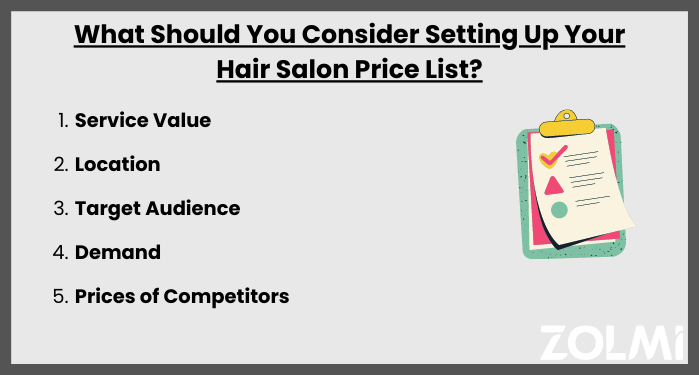
Your overall salon price strategy, as well as any promotions or discounts that you decide to offer your clients will depend a lot on your long-term goals and your salon’s position in the market.
Salon owners often choose or modify this strategy to keep up with or stimulate demand for different hair salon services or add ons. One of the best tips for success is knowing when to offer discounts and when to take control and raise a price to increase profit.
Here is an overview of the different pricing strategies in the beauty industry, along with some tips so that you can decide what will work best for your own salon business:
This is often used by hair salon owners looking to attract more clients. If you’re new in the area or to the business, this may be the right way to go. You start out by asking clients to pay lower prices, then raise the price later on.
While this does have the advantage of getting appointments booked for your stylists and getting clients in the door, it’s not always the right tactic. After customers get used to paying a certain amount of money for a haircut or color, it can be hard to raise prices later on.
You’ll also need to keep control of your salon business image. Undercharging your customers could affect people’s perceptions about the quality of your services or attract the wrong target demographic.
This strategy takes your customers’ preferences into account and charges accordingly. You’ll need to look at what each potential client values and what they’re willing to pay for a service.
For this to work well, you’ll really need to understand your clientele. You’ll have to know what they want, what things they tend to avoid, and which hair salon services they value most. Then, you can budget for each of these things.
This tends to work well for experienced hair salon owners who talk to their clients often or those who’ve been in the industry for a number of years.
This is one way to simplify your pricing plan and involves setting higher prices for new or exclusive hair salon services, then moving these costs lower over time.
One example of this would be initially charging a higher amount for a new hair extensions technique or service, gaining maximum profit while it is trending, then decreasing this price later once the novelty wears off.
This technique often works well when you want to draw in the type of client who can afford to pay more per service, before later attracting others who became interested because of them.
Does your salon have a prestigious brand? Are your hairstylists experienced or well-known? If the answer is yes, then prestige pricing can be effective for your business.
Customers are often willing to spend more per service if your hair salon is seen as superior in some way. This is also known as “image pricing” and capitalizes on the perceived value of your salon’s brand. It’s a good strategy if you already stand out from the competition.
This can be extremely successful if it’s done carefully. An economy hair salon pricing strategy sets your business and services apart as being more affordable than your competitors. Take a look at what’s offered in your area, already.
While you’ll still need to be careful of undercharging and keep an eye on the average hair salon prices in your area, you can target clients from lower or fixed-income markets, such as students, young families or senior citizens. This lets you appeal to a price-sensitive audience.
The structure of your hair salon price list will connect to the strategy you’ve chosen and any discounts that your business decides to offer. Your industry salon strategy and salon services offered will work together to dictate how you approach your pricing.
Here are some of the most common approaches, as well as tips for how they work:
This is the most straightforward and involves charging one price per service, regardless of the time, products used, stylists, etc. This makes each amount easy for stylists and clients to calculate, but leaves no room for flexibility.
In this case, a hair salon would charge one price for all coloring services, regardless of the type of color or the length of clients hair. This is usually done by either very premium or very low-cost businesses.
This strategy starts clients out with a basic price for a hair salon service, then allows them to add more items to this from the list, gradually increasing the amount. This formula allows for transparency (which clients like), and the chance to make a profit when they spend more.
For example, a client booking a haircut would pay one price, but if the stylist adds a wash to this the price goes up. If they want a cut, wash, hair treatment and a scalp massage, the expense of the service increases per each item.
You can also apply this to bookings with more experienced or prestigious stylists by charging a premium price for appointments with them, and a standard cost for other team members.
This is only recommended for complicated or multi-step color treatments or hair salon services when it’s hard to break down these special cases on your basic menu.
Telling your clients to “call us for more information on pricing” is helpful when calculating the costs of complex services. For more common hair salon appointments, though, you’ll still need to set salon service prices that are clear and easy for clients to understand.
This is a combination of the last two, providing a fixed cost menu for clients, as well as consulting with them when pricing out more involved services or procedures.
This can work well at salons that specialize in more complex services, such as extensions or multi-stage hair coloring.
Some salon owners decide to discount an initial service, then make their money by upselling more expensive extras. You might list a low price for a core hair salon services such as a cut, then encourage your team to upsell add ons such as a conditioning treatment or a blowout.
This can be a good way to motivate each stylist and increase the number of hair salon services per visit.
People often ask “How much should I charge for hair services?” To find the answer, we’ll have to find out how much each service costs the hair salon.
To start, you’ll have to look at every service and divide it by the time it takes (a $120 coloring job that takes two hours is 120 divided by 120 minutes = $1.00 per minute, for example). You’ll need to do this with every price hair salon services on your menu. Once you have these numbers, you can calculate everything else.
Ultimately, each of your salon service prices will cover running expenses, salaries for team members, and any products used. Let’s take a closer look:
This is your overall monthly budget and includes all your expenses for the year. List out the money you use on things like rent, marketing, taxes, utilities, cleaning, supplies, insurance, etc.
Salon Running Costs = (Rent + Supplies + Marketing + Taxes + Utilities + Cleaning + Insurance) / 12
Here is an example of how this works:
A salon with a yearly rent of $40,000, with supplies costing $10,000, marketing costs of $4,000, yearly utilities of $10,000, cleaning expenses of $4,000 and insurance costing $1,000 would have a running cost of $72,000, or $6,000 per month.
Now, how do you incorporate this large number of costs into a single haircut? With time and practice.
The next step is to figure out how many hours your salon is open per month and multiply this by the number of available working spaces (chairs).
A salon that’s open 10 hours a day, Monday through Saturday, with seven chairs would have a Total Monthly Working Time of (10 hours x 24 days a month) x 7 chairs = 1,680.
Now that you have your running costs per year, divide that by 12 months, divide it again by the total monthly working hours, and finally divide this number by 60. This will give you the running cost per minute.
The basic formula is:
Running Cost Per Minute = Running Cost Per Year / 12 / Total Working Time Per Month / 60
Here’s an example:
Running Cost Per Year ($72,800)/ 12 months / Total Monthly Working Time (1,680 hours)/ 60 = $0.06.
Remember, keeping a business open is never free. This is a measure of how much money it costs you and your team to provide services.
Every product you use, along with its quantity can just be added up. You’ll need to calculate the different salaries for each staff level (trainees, experienced stylists, etc.).
To do this, take each staff member’s salary, divide by their working hours per month, and then divide by 60. This is their cost per minute. So, if a stylist makes $2250 a month and works 40 hours a week, here’s how you could calculate it:
Staff member’s Salary ($2,250) / their Working Hours Per Month (160) / 60 = Staff Cost per Minute of $0.23.
To find this number, break down your running cost per minute, plus your staff cost per minute, multiply this by your service time and then add the cost of products used.
The basic formula is:
Service Cost = (Running Cost per Minute + Staff Cost per Minute) x Service Time + Products Used
Let's break it down using the numbers from our previous calculations, assuming that for the sake of this one the hair color and other products cost $25 total, and the whole job took two hours to complete:
Service Cost = (Running Cost Per Minute ($0.06) + Staff Cost Per Minute ($0.23)) x Service Time (120 mins) + Products Used ($25) = ($59.80)
Now, you’ll need to make a profit. This is why undercharging can be such a problem, when you think about it. This is where your salon pricing strategy comes in.
It’s time to add the margin that you’ve decided on and get your final price hair salon services.
The average salon profit margin ranges anywhere from 2% to 17%.
The formula is as follows:
Service Price = Service Cost x (1 + Margin)
Salon software can help you with how to price hair salon services. Salon software includes a calculator to break everything down for you, making all this math easy. This will go a long way towards saving you valuable time and money.
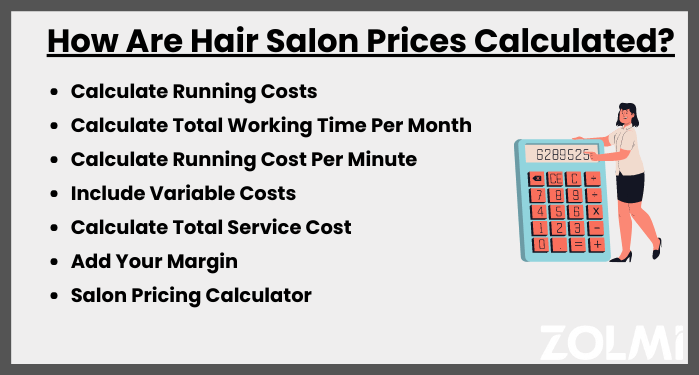
Prices for product sales are usually set by manufacturers, but they will usually give you a certain range that you can work within. Take a look on the product’s website and see what recommendations they have for retailers.
Delivery and storage aren’t free, so make sure to cover these expenses. Depending on the products and your target market, your salon retail margin will usually fall between 50 to 100%.
Here are some different strategies to help you approach each price hair salon services point:
Manufacturers that want to standardize the price of their products across different salons will provide this. Usually, retailers will sell the products to you at discounts of about half this price, allowing you to make a profit.
This is when you sell multiple items together for a single price. One common type of bundle is a shampoo, conditioner and styling product sold together. This allows retailers to make multiple sales and make profits from volume sold.
This is also convenient for customers, but it can make it hard to sell these items individually for a higher price, at a later date.
Many grocery stores do this. The strategy involves attracting customers with a lower-priced item that they want, then convincing them to buy additional products while they’re shopping.
This is when you check your competitor’s average hair salon prices, then deliberately set yours lower in order to make more sales. This often works, but it also makes it hard to raise prices hair salon services later on, if you want to change things.
This is the opposite and involves charging top dollar for what are perceived as premium or superior quality products. This strategy often works best at upmarket or prestigious salons.
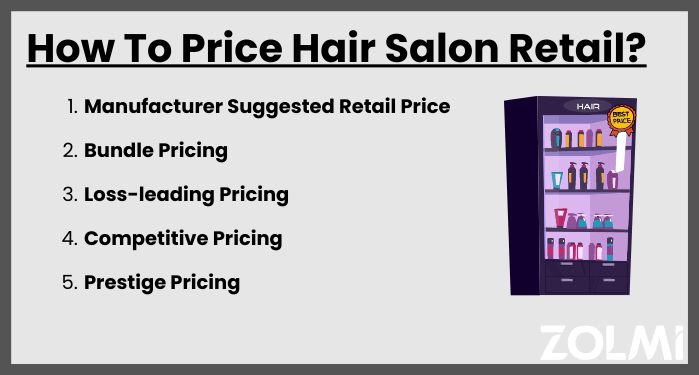
If you offer customers too many services, extensions and custom options, they’ll probably become confused and reluctant to choose. This will also make things harder for your staff. Use simple terms and easy to understand language.
Only offer discounts when it’s appropriate (such as on products about to expire, or for trainee services, etc.). Although clients love saving money, you want to avoid losing profits and devaluing your services.
Don’t give in to the temptation to drop your salon service prices at the first sign of trouble. Any business website will tell you that every salon has its ups and downs. Always remember the true value of your services.
It may sound silly, but people really are happier paying $99 for something, rather than $100. It feels like a lower price. Use partial numbers and avoid decimal places, which lengthen prices.
Your staff need specialized training for services like weaves or hair extensions. Make sure to include these when calculating your yearly costs.
Remember to be transparent and tell clients the reason for these changes. Train your team to talk to them, too.
When you decide “how to price my hair services” you’ll need to determine what these salon services are, too.
Your hair salon menu should include things like haircut services for men, women and children (unless you decide to specialize), as well as hair coloring, styling, conditioning treatments, texture salon services, extensions and any other exclusive treatments that you offer.
Don’t forget to put all of these online on your salon’s website, too.
Using a free template is a great way to get started. Here is a free price list example that you can use or modify to suit your own salon’s business needs.
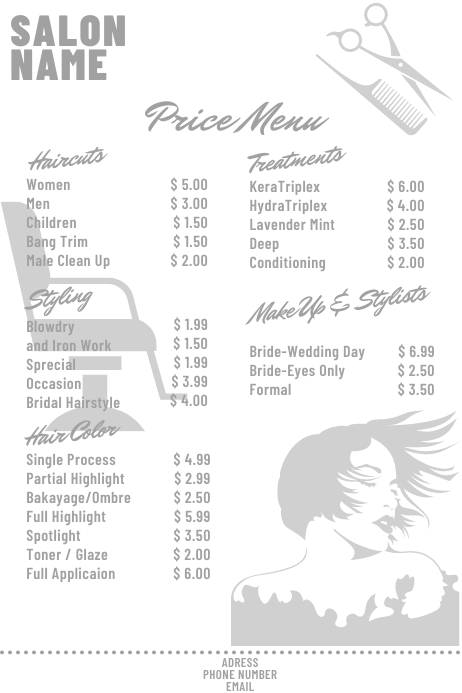
Although it might seem daunting at first, setting your salon prices can be both rewarding and the best way to get control of your small business.
Remember, knowledge is power. Once you’ve decided on your business strategy and you’ve determined exactly what you need to do to make money, it’ll become much easier to run your salon successfully on a daily basis.
Using these tips and strategies, you can set salon pricing that works for you and helps your business to continue to grow.
Is it time to rethink your pricing strategy
http://gsl-archive.mit.edu/media/programs/mexico-summer-2015/materials/is_it_time_to_rethink_your_pricing_strategy.pdf
10 Asset Pricing Implications of Equilibrium Business Cycle Models
https://www.degruyter.com/document/doi/10.1515/9780691218052-014/html
A strategic approach to industrial product pricing: The pricing plan
https://www.sciencedirect.com/science/article/pii/S0019850104001208